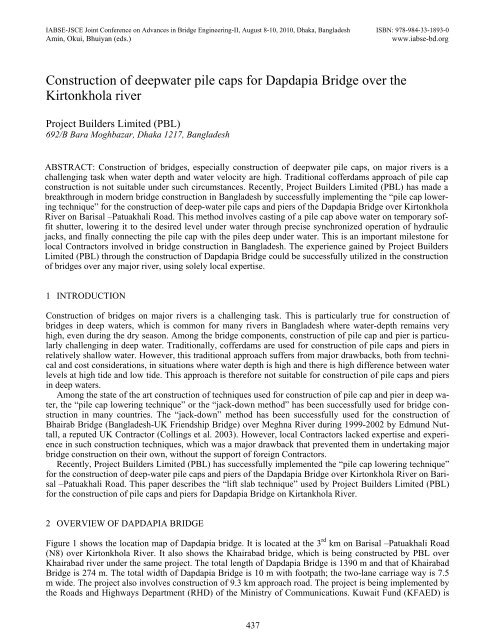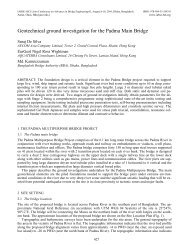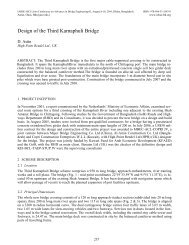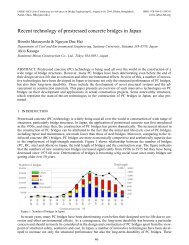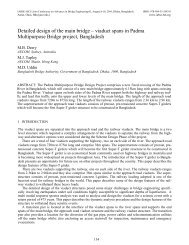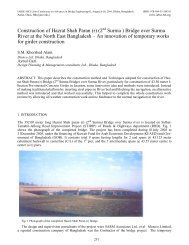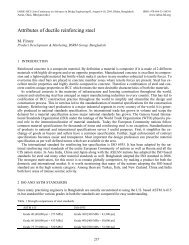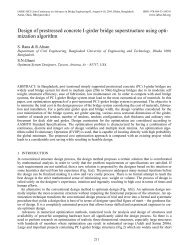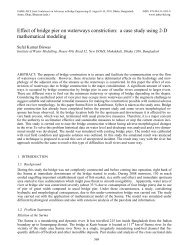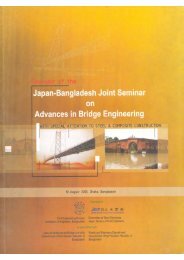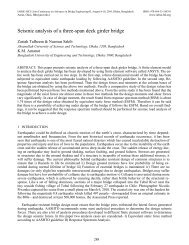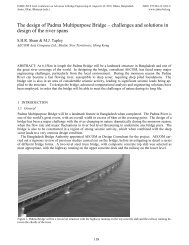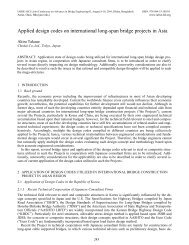Construction of deepwater pile caps for Dapdapia Bridge over the ...
Construction of deepwater pile caps for Dapdapia Bridge over the ...
Construction of deepwater pile caps for Dapdapia Bridge over the ...
Create successful ePaper yourself
Turn your PDF publications into a flip-book with our unique Google optimized e-Paper software.
IABSE-JSCE Joint Conference on Advances in <strong>Bridge</strong> Engineering-II, August 8-10, 2010, Dhaka, Bangladesh ISBN: 978-984-33-1893-0<br />
Amin, Okui, Bhuiyan (eds.) www.iabse-bd.org<br />
<strong>Construction</strong> <strong>of</strong> <strong>deepwater</strong> <strong>pile</strong> <strong>caps</strong> <strong>for</strong> <strong>Dapdapia</strong> <strong>Bridge</strong> <strong>over</strong> <strong>the</strong><br />
Kirtonkhola river<br />
Project Builders Limited (PBL)<br />
692/B Bara Moghbazar, Dhaka 1217, Bangladesh<br />
ABSTRACT: <strong>Construction</strong> <strong>of</strong> bridges, especially construction <strong>of</strong> <strong>deepwater</strong> <strong>pile</strong> <strong>caps</strong>, on major rivers is a<br />
challenging task when water depth and water velocity are high. Traditional c<strong>of</strong>ferdams approach <strong>of</strong> <strong>pile</strong> cap<br />
construction is not suitable under such circumstances. Recently, Project Builders Limited (PBL) has made a<br />
breakthrough in modern bridge construction in Bangladesh by successfully implementing <strong>the</strong> “<strong>pile</strong> cap lowering<br />
technique” <strong>for</strong> <strong>the</strong> construction <strong>of</strong> deep-water <strong>pile</strong> <strong>caps</strong> and piers <strong>of</strong> <strong>the</strong> <strong>Dapdapia</strong> <strong>Bridge</strong> <strong>over</strong> Kirtonkhola<br />
River on Barisal –Patuakhali Road. This method involves casting <strong>of</strong> a <strong>pile</strong> cap above water on temporary s<strong>of</strong>fit<br />
shutter, lowering it to <strong>the</strong> desired level under water through precise synchronized operation <strong>of</strong> hydraulic<br />
jacks, and finally connecting <strong>the</strong> <strong>pile</strong> cap with <strong>the</strong> <strong>pile</strong>s deep under water. This is an important milestone <strong>for</strong><br />
local Contractors involved in bridge construction in Bangladesh. The experience gained by Project Builders<br />
Limited (PBL) through <strong>the</strong> construction <strong>of</strong> <strong>Dapdapia</strong> <strong>Bridge</strong> could be successfully utilized in <strong>the</strong> construction<br />
<strong>of</strong> bridges <strong>over</strong> any major river, using solely local expertise.<br />
1 INTRODUCTION<br />
<strong>Construction</strong> <strong>of</strong> bridges on major rivers is a challenging task. This is particularly true <strong>for</strong> construction <strong>of</strong><br />
bridges in deep waters, which is common <strong>for</strong> many rivers in Bangladesh where water-depth remains very<br />
high, even during <strong>the</strong> dry season. Among <strong>the</strong> bridge components, construction <strong>of</strong> <strong>pile</strong> cap and pier is particularly<br />
challenging in deep water. Traditionally, c<strong>of</strong>ferdams are used <strong>for</strong> construction <strong>of</strong> <strong>pile</strong> <strong>caps</strong> and piers in<br />
relatively shallow water. However, this traditional approach suffers from major drawbacks, both from technical<br />
and cost considerations, in situations where water depth is high and <strong>the</strong>re is high difference between water<br />
levels at high tide and low tide. This approach is <strong>the</strong>re<strong>for</strong>e not suitable <strong>for</strong> construction <strong>of</strong> <strong>pile</strong> <strong>caps</strong> and piers<br />
in deep waters.<br />
Among <strong>the</strong> state <strong>of</strong> <strong>the</strong> art construction <strong>of</strong> techniques used <strong>for</strong> construction <strong>of</strong> <strong>pile</strong> cap and pier in deep water,<br />
<strong>the</strong> “<strong>pile</strong> cap lowering technique” or <strong>the</strong> “jack-down method” has been successfully used <strong>for</strong> bridge construction<br />
in many countries. The “jack-down” method has been successfully used <strong>for</strong> <strong>the</strong> construction <strong>of</strong><br />
Bhairab <strong>Bridge</strong> (Bangladesh-UK Friendship <strong>Bridge</strong>) <strong>over</strong> Meghna River during 1999-2002 by Edmund Nuttall,<br />
a reputed UK Contractor (Collings et al. 2003). However, local Contractors lacked expertise and experience<br />
in such construction techniques, which was a major drawback that prevented <strong>the</strong>m in undertaking major<br />
bridge construction on <strong>the</strong>ir own, without <strong>the</strong> support <strong>of</strong> <strong>for</strong>eign Contractors.<br />
Recently, Project Builders Limited (PBL) has successfully implemented <strong>the</strong> “<strong>pile</strong> cap lowering technique”<br />
<strong>for</strong> <strong>the</strong> construction <strong>of</strong> deep-water <strong>pile</strong> <strong>caps</strong> and piers <strong>of</strong> <strong>the</strong> <strong>Dapdapia</strong> <strong>Bridge</strong> <strong>over</strong> Kirtonkhola River on Barisal<br />
–Patuakhali Road. This paper describes <strong>the</strong> “lift slab technique” used by Project Builders Limited (PBL)<br />
<strong>for</strong> <strong>the</strong> construction <strong>of</strong> <strong>pile</strong> <strong>caps</strong> and piers <strong>for</strong> <strong>Dapdapia</strong> <strong>Bridge</strong> on Kirtankhola River.<br />
2 OVERVIEW OF DAPDAPIA BRIDGE<br />
Figure 1 shows <strong>the</strong> location map <strong>of</strong> <strong>Dapdapia</strong> bridge. It is located at <strong>the</strong> 3 rd km on Barisal –Patuakhali Road<br />
(N8) <strong>over</strong> Kirtonkhola River. It also shows <strong>the</strong> Khairabad bridge, which is being constructed by PBL <strong>over</strong><br />
Khairabad river under <strong>the</strong> same project. The total length <strong>of</strong> <strong>Dapdapia</strong> <strong>Bridge</strong> is 1390 m and that <strong>of</strong> Khairabad<br />
<strong>Bridge</strong> is 274 m. The total width <strong>of</strong> <strong>Dapdapia</strong> <strong>Bridge</strong> is 10 m with footpath; <strong>the</strong> two-lane carriage way is 7.5<br />
m wide. The project also involves construction <strong>of</strong> 9.3 km approach road. The project is being implemented by<br />
<strong>the</strong> Roads and Highways Department (RHD) <strong>of</strong> <strong>the</strong> Ministry <strong>of</strong> Communications. Kuwait Fund (KFAED) is<br />
437
providing 80% funding <strong>for</strong> <strong>the</strong> project; <strong>the</strong> KCIC (Kuwait)-ACE (Egypt)-DDC (Bangladesh) is <strong>the</strong> consultant<br />
<strong>for</strong> <strong>the</strong> project. Table 1 shows some important features <strong>of</strong> <strong>Dapdapia</strong> <strong>Bridge</strong>.<br />
Proposed Link Road<br />
Figure 1: Location <strong>of</strong> <strong>Dapdapia</strong> bridge on Barisal-Patuakhali road<br />
Table 1: Important features <strong>of</strong> <strong>Dapdapia</strong> <strong>Bridge</strong><br />
Sl. No. Name <strong>of</strong> Item Description<br />
1 Structure Type Pre-stressed Concrete Segmental Box Girder<br />
2 River Type Category A<br />
3 Vertical Clearance 18.30 M<br />
4 Horizontal Clearance 76.20 M<br />
5 No. <strong>of</strong> Spans 26 Nos. @ 30 M<br />
2 Nos. @ 48.5 M<br />
6 Nos. @ 85 M<br />
34 Nos.=1390M<br />
6 Foundation Type R.C.C. Pile Foundation <strong>of</strong> Diameter 1.00/1.20 M<br />
7 No <strong>of</strong> Piles 244 nos.<br />
8 No <strong>of</strong> Piers 33 nos.<br />
9<br />
Width-10 meter with foot path at each side; Carriage<br />
Width and Lane<br />
way-7.5m (2-lane)<br />
As noted earlier, <strong>pile</strong> <strong>caps</strong> and piers <strong>for</strong> bridges are constructed by erecting large diameter sheet <strong>pile</strong> c<strong>of</strong>ferdams,<br />
which provide <strong>the</strong> dry environment needed <strong>for</strong> construction works. Usually c<strong>of</strong>ferdams consisting <strong>of</strong><br />
two rows <strong>of</strong> sheet <strong>pile</strong>s are used. The infill material between <strong>the</strong> two rows <strong>of</strong> sheet <strong>pile</strong> is provided to withstand<br />
<strong>the</strong> hydrostatic pressure and to limit <strong>the</strong> water seepage from <strong>the</strong> dam’s wall. Usually a thick mass concrete<br />
water plug is used to limit <strong>the</strong> water seepage from <strong>the</strong> bottom <strong>of</strong> <strong>the</strong> working space and also to contain<br />
<strong>the</strong> riverbed during construction. A continuous de-watering system is run to keep <strong>the</strong> working space dry during<br />
construction.<br />
438
However, as noted earlier, this method is workable only <strong>for</strong> relatively shallow water depths and not suitable<br />
<strong>for</strong> deep water <strong>pile</strong> cap/pier construction. As water depth and water velocity increases, this method becomes<br />
unsuitable both from technical and cost considerations. The depth <strong>of</strong> Dapadapia River exceeds 13 m<br />
and water velocity <strong>of</strong>ten exceeds 2.5 m/sec. There<strong>for</strong>e, <strong>the</strong> traditional c<strong>of</strong>ferdam approach cannot be used <strong>for</strong><br />
construction <strong>of</strong> <strong>Dapdapia</strong> <strong>Bridge</strong>.<br />
Based on <strong>the</strong> field condition and experience (Collings et al., 2003; Hinch et al., 1984; Candler et al., 1984),<br />
<strong>the</strong> “lift slab technique” or “jack-down method” or “lowering method” was considered suitable <strong>for</strong> <strong>pile</strong> cap<br />
construction <strong>of</strong> <strong>Dapdapia</strong> bridge. This method has certain advantages, e.g., it is quicker and more economical<br />
than traditional method; it is also safer and could be implemented with minimum disrupting navigation. However,<br />
local contractors never implemented this method/ technique on <strong>the</strong>ir own and <strong>the</strong>re<strong>for</strong>e it a major construction<br />
challenge.<br />
3 CONSTRUCTION OF DEEPWATER PILE CAPSE<br />
The “lift slab technique” involves casting <strong>pile</strong> cap and pier above water and incrementally lowering <strong>the</strong>m<br />
down <strong>the</strong> <strong>pile</strong>s using hydraulic jacks. For this purpose, <strong>the</strong> steel <strong>pile</strong> casings were specially extended above<br />
water level (minimum 500 mm above HWL). The casings were filled with sand from <strong>the</strong> top <strong>of</strong> concrete level<br />
up to about <strong>the</strong> water level (see Fig. 2). On top <strong>of</strong> <strong>the</strong> sand fill within <strong>the</strong> steel casing, steel section were<br />
erected with concrete, on top <strong>of</strong> which <strong>the</strong> lifting beams (steel I beams) were fixed (see Fig. 2).<br />
The <strong>pile</strong> cap was <strong>the</strong>n cast (in two stages) above water level on temporary s<strong>of</strong>fit shutter. During casting,<br />
portions <strong>of</strong> <strong>the</strong> <strong>pile</strong> cap around each <strong>pile</strong> were boxed out (that is not concreted) <strong>for</strong>: (i) keeping sliding gaps<br />
(<strong>for</strong> sliding <strong>the</strong> <strong>pile</strong> cap) around each <strong>pile</strong>, and (ii) keeping space <strong>for</strong> structurally connecting <strong>the</strong> <strong>pile</strong> cap with<br />
<strong>the</strong> <strong>pile</strong>s. Lifting rods were set in <strong>the</strong> <strong>pile</strong> cap <strong>for</strong> connecting it to <strong>the</strong> lifting jacks. The lifting jack system, fitted<br />
with hydraulic pump, was installed on top <strong>of</strong> <strong>the</strong> lifting beams; <strong>the</strong>se lifting jacks were connected to <strong>the</strong><br />
<strong>pile</strong> cap through <strong>the</strong> connecting rods. Once <strong>the</strong> <strong>pile</strong> cap has been cast and cured and <strong>the</strong> hydraulic lifting jack<br />
system is in place, <strong>the</strong> <strong>pile</strong> cap was lifted <strong>of</strong>f <strong>the</strong> shutter, and <strong>the</strong> s<strong>of</strong>fit shutter system was removed from underneath.<br />
At this stage, <strong>the</strong> <strong>pile</strong> cap, held entirely by <strong>the</strong> lifting jacks, was ready <strong>for</strong> lowering.<br />
Figure 2: Fixing <strong>of</strong> lifting beam on top <strong>of</strong> steel <strong>pile</strong> casing (schematic view)<br />
The <strong>pile</strong> cap was <strong>the</strong>n lowered in water down <strong>the</strong> <strong>pile</strong>s through precise synchronized operation <strong>of</strong> <strong>the</strong> hydraulic<br />
jacks up to a depth so that <strong>the</strong> top level <strong>of</strong> <strong>the</strong> <strong>pile</strong> cap remains above water (see Fig. 3); this reduced<br />
<strong>the</strong> effective weight <strong>of</strong> <strong>the</strong> <strong>pile</strong> cap. In order to create a dry environment underwater <strong>for</strong> making structural<br />
concrete connections between <strong>the</strong> <strong>pile</strong>s and <strong>the</strong> <strong>pile</strong> cap, large diameter (2500 mm) steel watertight caissons<br />
were fixed and sealed to <strong>the</strong> top <strong>of</strong> <strong>the</strong> <strong>pile</strong> cap around each <strong>pile</strong>. Considering <strong>the</strong> safety <strong>of</strong> people who would<br />
work deep under water within <strong>the</strong> caissons, extreme care were taken in quality control and quality assurance<br />
<strong>of</strong> all works.<br />
439
Figure 3: Lower <strong>of</strong> <strong>pile</strong> cap in progress through precise synchronized operation <strong>of</strong> hydraulic jacks<br />
At this stage pier construction on <strong>the</strong> <strong>pile</strong> cap commenced; <strong>the</strong> piers were constructed in stages. As <strong>the</strong> pier<br />
construction progressed, <strong>the</strong> <strong>pile</strong> cap toge<strong>the</strong>r with <strong>the</strong> steel caissons was lowered gradually using <strong>the</strong> hydraulic<br />
jack system, always keeping <strong>the</strong> top <strong>of</strong> <strong>the</strong> pier above water level. Following this process, <strong>the</strong> <strong>pile</strong> cap was<br />
lowered up to <strong>the</strong> desired level; <strong>the</strong> top <strong>of</strong> <strong>the</strong> steel caissons remained above <strong>the</strong> water level.<br />
Once <strong>the</strong> <strong>pile</strong> cap was in place, <strong>the</strong> sliding gaps between <strong>the</strong> <strong>pile</strong> cap and <strong>the</strong> <strong>pile</strong> casings were sealed and<br />
water was pumped out from within <strong>the</strong> steel caissons to create a dry working space. Arrangements were <strong>the</strong>n<br />
made to transfer <strong>the</strong> load <strong>of</strong> <strong>the</strong> <strong>pile</strong> cap to <strong>the</strong> <strong>pile</strong>s, so that <strong>the</strong> hydraulic jacks, which still held <strong>the</strong> weight <strong>of</strong><br />
<strong>the</strong> <strong>pile</strong> cap, could be released. The lifting jacks were <strong>the</strong>n removed and <strong>the</strong> <strong>pile</strong> cap rested on <strong>the</strong> <strong>pile</strong>s. The<br />
sections <strong>of</strong> steel <strong>pile</strong> casings above <strong>the</strong> concrete level were also removed at this stage to create working space<br />
at <strong>the</strong> base <strong>of</strong> <strong>the</strong> <strong>pile</strong> cap below water level. A de-watering system was run to keep <strong>the</strong> working space within<br />
<strong>the</strong> caissons dry. Rein<strong>for</strong>ced concrete works <strong>for</strong> connecting <strong>the</strong> <strong>pile</strong> cap to <strong>the</strong> <strong>pile</strong>s were <strong>the</strong>n completed in<br />
stages. The steel caissons around <strong>the</strong> <strong>pile</strong>s were <strong>the</strong>n removed and <strong>the</strong> <strong>pile</strong> cap construction reached its completion.<br />
4 CONCLUSIONS<br />
The construction <strong>of</strong> <strong>Dapdapia</strong> bridge is near completion. The experience gained by Project Builders Limited<br />
(PBL) through <strong>the</strong> construction <strong>of</strong> <strong>Dapdapia</strong> <strong>Bridge</strong> could be successfully utilized in <strong>the</strong> construction <strong>of</strong><br />
bridges <strong>over</strong> major rivers anywhere in Bangladesh or elsewhere, using solely local expertise.<br />
ACKNOWLEDGEMENT<br />
Project Builders Limited (PBL) gratefully acknowledges <strong>the</strong> support provided by <strong>the</strong> Project Directors <strong>of</strong> <strong>the</strong><br />
Roads and Highways Department (RHD) and <strong>the</strong> Consultant throughout <strong>the</strong> construction works.<br />
REFERENCES<br />
Collings, D., Mizon, D. and Swift, P. (2003), Design and <strong>Construction</strong> <strong>of</strong> <strong>the</strong> Bangladesh-UK Friendship <strong>Bridge</strong>, <strong>Bridge</strong> Engineering<br />
156, Issue BE4, p. 181-190.<br />
Hinch, L. W., McDoWell, D. M. and Rowe, P. W. (1984), Jamuna River: 230 kV crossing, Bangladesh. I: Design <strong>of</strong> foundations.<br />
Proceedings <strong>of</strong> <strong>the</strong> Institution <strong>of</strong> Civil Engineers, Part 1, 76, 927-949.<br />
Candler, J. A., Peraino, J. and Rowe, P. W. (1984), Jamuna River: 230 kV crossing, Bangladesh. III: <strong>Construction</strong> <strong>of</strong> foundations.<br />
Proceedings <strong>of</strong> <strong>the</strong> Institution <strong>of</strong> Civil Engineers, Part 1, 76, 965-98<br />
440


